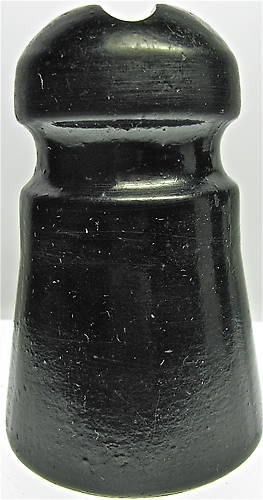Mystery Pony Insulator!
By Caleb Thimell; posted February 16, 2012
View Original: Click to zoom, then click to magnify (1282 x 2433) 1330KB

|
Here's a really cool and unusual pony style insulator that I have never seen before anywhere. This peculiar unembossed insulator was recovered in Chile about 10 years ago but was most likely made in England or France. Update: expert from France has never seen this model before. The dimensions are 2" w x 3 3/16" ht. No inner skirt. What is so special about this? First of all, it is made of pure blackglass- not an ounce of tint of another color. Second, it is not made of typical glass. Oddly, it feels like plastic- even sounds like plastic when you click fingernails to the surface. But it is probably mica because when I click my teeth on it it clinks like glass. Micanite is a mixture of mica and ebonite used in early 1900 insulators. Also one can see what looks like tiny mica fragments in the outer surface areas. Third, the pinhole is only half inch wide- which nearly always indicates British origins. Other very early insulators in previously unknown styles have been found in British museums made of blackglass too. Fourth, as an export item insulators usually would have an embossing to either advertise the manufacturer and/or designate the line they were being used for- unless it was an experimental item (like the British Pilkington examples used in Uruguay) or it was made before the export regulation requiring country of origin marking. Fifth, the thread pitch is unusual at 1/4 inch [id=333983362]. Sixth, appears to have been made in a 4 piece mold as there are three skirt mold lines with cross hatch lines [id=333983910] and presumably one piece for the dome. No inner skirt. Finally, why put a cable groove (albeit tiny) on the dome for such a tiny insulator obviously not intended and clearly incapable to carry a high voltage line? Since 99% of early French export insulators to South America are found with embossings and are usually semi-transparent dark green glass- and the other clues (pinhole and odd glass texture and 1/4 inch thread pitch), I am putting my best guess on this item being a rare British made export for a railway telegraph line in Chile. I'd love to hear from you if you have additional information such as having seen this item in an old catalog or European museum, etc. Thanks! |